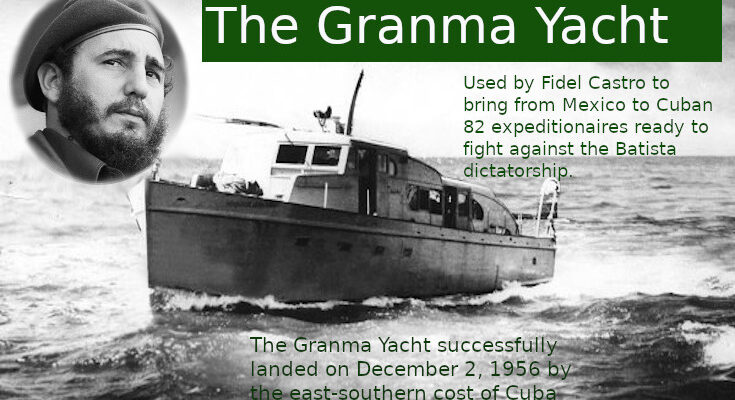Once the group of revolutionary men led by Fidel Castro was prepared in Mexico and ready to return to Cuba and fight for the island’s freedom, they needed a boat for the trip.
Fidel had first tried to buy the Catalina seaplane, but its high price was beyond the reach of the young and small group who did not have the best financial conditions. The second attempt was an old U.S. Navy Crash Tender.
There were many of these fast and maneuverable vessels for sale in Florida ports, but the buyers were subject to intense scrutiny by the Coast Guard and the FBI because they were acquired by smuggling gangs.
Finally the third attempt succeeded and the group was able to pay the price of 50,000 Mexican pesos for the Granma Yacht, supposedly named after the grandmother (grandmother, short for granma) of its first owner (an American), was dilapidated and its two diesel engines were in need of repair. The 13.25-meter wooden yacht, with a beam of 4.76 meters, a beam of 4.76 meters and a 2.40-meter prop, was designed for 12 passengers and could only fit about 20 comfortably.
At two o’clock in the morning on November 25, 1956, the 60-foot (18 m) diesel-powered, 1943-built Wheeler Shipbuilding of Brooklyn, New York, rattling, rusting motor yacht slipped out of the Mexican port of Tuxpan, Veracruz. She set sail for a thousand-mile voyage through the perilous waters of the Gulf of Mexico.
For this momentous cruise there were 82 members of the revolutionary group Movimiento 26 de Julio. At the head of this small but courageous group was a Cuban lawyer who had just been released from prison. He had been imprisoned for political activity and had used his time to sharpen his political knowledge by reading Marx, Engels, Lenin, as well as South American anti-imperialist writers.
Also on the Granma were other revolutionaries who would play their part in the liberation of Cuba and its people. Among them were Fidel’s brother Raul, Ernesto “Che” Guevara and Camilo Cienfuegos.
At the helm of the Granma was Norberto Collado Abreu, a veteran of the Cuban navy and a staunch supporter of Fidel and his plan to bring socialism to their shared island home.
They had purchased the small yacht, named by the original owner as a tribute to his grandmother, for only $15,000 from a Florida dealer through a Mexican agent. The deal did not close until October 19, just over a month before they were to set sail.
Antonio del Condo, an arms dealer from Mexico City and a friend and sympathizer of Fidel’s group, found the small yacht and, although it was not perfect, it would prove suitable for the job.
Antonio del Condo was always known as “El Amigo”.
Those who sailed on the Granma would later be known collectively as “The expeditionaries of the Granma yacht”.
Their journey would not be easy. For more than a week, the overloaded yacht had to battle unfriendly seas.
The Granma was leaking and the pumps needed constant attention. Provisions were scarce. Seasickness sapped the crew’s morale and efficiency.
Finally, on December 2, they landed at Playa Las Coloradas, in what is now known as Granma province.
The landing site was carefully chosen. Sixty-one years earlier, national hero José Martí had landed in the same place during the wars of independence from Spanish colonial rule.
In his later writings, Che Guevara would recall the landing on Cuban soil: “We arrived on dry land, lost, stumbling around like so many shadows or ghosts marching in response to some obscure psychic impulse.
“We had spent seven days of constant hunger and sickness during the sea crossing, crowned by three even more terrible days on land. Exactly 10 days after our departure from Mexico, in the early morning of December 5, after a night march interrupted by fainting spells and frequent rests, we arrived at a place paradoxically known as Alegria de Pio.
Fidel and his band took refuge in the hills: the Sierra Maestra. The guerrilla war had begun. The 82 became hundreds, the hundreds became thousands.
By the end of 1958, Fidel had left the Sierra Maestra and Cubans all over the island rallied to his cause. After Castro captured Santa Clara, the dictator Batista fled with his family into exile, first to the Dominican Republic, then to Madeira and finally to Estoril, Portugal.

